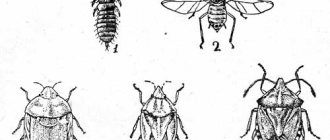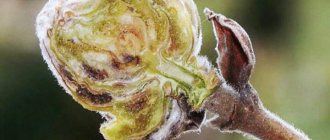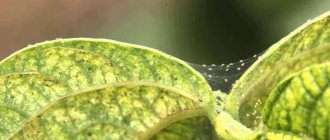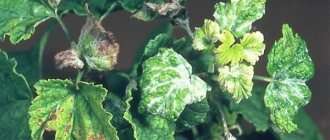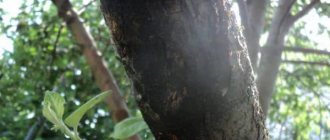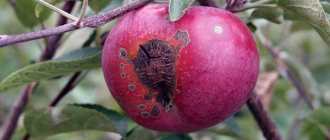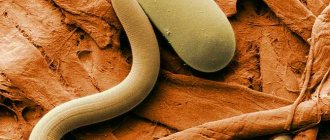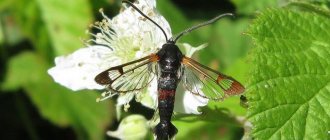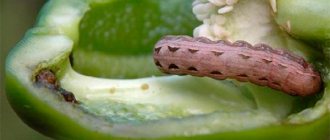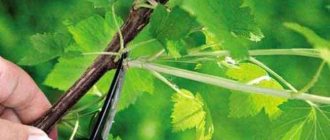The article describes spider mites on currants: how to combat the pest at different stages of the life of the bush, all means of control (chemical, biological), preventive measures.
It is known that all types of currants contain more nutrients and healing substances than other berries, therefore, if a spider mite appears on the bush, which destroys the leaves on the currant, the harvest may be lost.
You need to choose a method of controlling pests that attack berries based on specific factors.
Time is one of the most important factors; you need to consider the specific period when the plant was occupied by this insect. “In the case when the spider mite appeared before the end of the ovary or before the currant began to bloom, then you need to make the maximum amount of effort to cope with the horde of mites, since the ripening of the crop is at stake. “If the fruits are lucky, they have already set and are now starting to sing, then the pest will not be able to cause significant damage to the fruits, but can affect the leaves. This provision does not affect cases where the currant bushes are completely covered with mites, because in this case it will be necessary
Another important factor is the extent of damage caused to fruit-bearing bushes by the pest. “If there are only a few of the currants, as indicated by the number of infected leaves, then physical methods of controlling spider mites will help. “If the currants are seriously damaged, then it will be necessary to use more damaging substances; the ripening of the berries will not affect anything. Gardeners have come up with a large number of ways to combat spider mites that have attacked currants; for this, they can use labor efforts, improvised methods, other plants, or even natural enemies of spider mites - small other insects. The article reflects the best ways to resist a spider colony, including spraying with acaricides, which is very dangerous for the pest.
Spider mites on currants: what threat does they pose?
Spider mites on currants: what threat does they pose?
A spider mite is a small spider that pierces a leaf with its mouthparts, like a needle, thereby drinking nutrients and juice from the plant; the leaves are deprived of chlorophyll, which is as important for currants as blood is for us, so you need to start fighting this harmful pest in a timely manner insects.
» The affected leaf in some places begins to resemble marble; white spots appear on it, which then darken. » Due to a lack of nutrients, the leaves curl and fall off, the insect moves to the not yet affected parts of the currant - to the stems, fruits or flowers, after which these parts also become entangled in a web. » In the summer, especially in dry, hot weather, the parasite multiplies very quickly, literally in 3 days hundreds of eggs are transformed into small insects that already infect the leaves, after a week they themselves begin to lay eggs. Due to this rate of reproduction, it will be difficult to fight insect families that have occupied the bushes. » The pest's days are numbered - they last a maximum of 24 days, but during this time females can lay hundreds of larvae.
Important fact! It was found that parasites on berries cannot tolerate excess moisture at any stage - thanks to this, you can fight spider mites with water.
Signs of appearance and description
It is difficult to see spider mites on a plant due to their small size, so it is easy to miss the initial stage of infection. Much more often, gardeners observe the destructive consequences of the pest’s activity - a thin cobweb has appeared on the leaves of currants or neighboring crops, the leaves wither, turn yellow and fall off, the growth of bushes bound by a gray cobweb is weakened.
If you see such signs, it means that the currant is suffering from an attack of spider mites
There are a number of tick families, numbering 1,270 species. They are arthropods with 4–8 legs (sometimes 2–6 at different life stages).
Did you know? Spider mites are not insects, as is commonly believed, but are representatives of the class of arachnids (subclass Mites - lat. Acari).
Agricultural pests in these groups cause damage by feeding on plant sap and releasing toxins into plant tissue. The most famous and widespread spider mite is the one with two spots. In addition to this, there are yellow and red ticks. They use webs as a means of transporting their large colonies and for protection from predators.
Tick development cycle:
- in March-April and October at +15°C it is 4 weeks;
- in May and September at +20°C - 3 weeks;
- in summer at +30°C - only 1 week.
The pest multiplies especially quickly in dry and warm conditions. Depending on weather conditions and location, the number of generations of ticks is 10–15 generations. In spring and summer their activity is destructive, but population growth declines before winter, and they do not cause as much damage in late autumn
Female mites overwinter under loose bark or in organic debris at the base of plants and on weeds. In the spring they emerge, disperse, and each lay about 100 0.14 mm eggs on the underside of the leaf (usually in recesses and along the veins).
The eggs hatch into larvae after a week, and after 2-3 weeks new reproductive individuals appear, and a new takeover of territories begins. At this point during the movement of pests, chemical controls can be most effective. When the mites find a suitable location, they dig into parts of the plant with their jaws, begin to feed on its juices, the contents of the cells along with chlorophyll grains, and stop moving.
Also find out how to deal with glassware on currants.
Infestation usually begins on the lower leaves of plants and then spreads upward. It is necessary to inspect the oldest leaves for spotting, and the larvae and mites themselves can be found on their undersides.
The body length of an adult tick is 0.4–0.6 mm; females are slightly larger than males. The body is soft, elongated, the back is convex, the abdomen is flat. The dark spots on the sides are transparent blind intestinal sacs. Adults have 8 legs, juveniles have 6.
The larvae are transparent, and the color of adult pests varies from light green to brownish-red depending on the plants they feed on and the environment. Wintering females are orange-red or bright red.
The small size of mites allows them to migrate among plants with the help of wind on cobwebs, on the paws of birds and insects. They cause the greatest harm during hot and dry periods in the southern regions of the non-chernozem zone.
Important! Spider mites pose no danger to people, pets, or birds; they do not bite and do not cause allergic reactions.
Spider mites on currants: how to deal with them before the bush starts flowering
Spider mites on currants: how to deal with them before the bush starts flowering
Before the currants begin to bloom, you can safely fight a huge number of pests with the help of acaricidal drugs, but such measures should be resorted to only in cases where other measures have not given the desired result.
» If you do not exterminate spider mites from currants before the ovary begins, the harvest may be lost altogether. » Red and white currants are more susceptible to attack by spider mites, so they are at greatest risk. “This pest, in addition to damaging the ovaries on flowers and harming the foliage in general, can also bring other diseases to currants - this is its drawback. “This applies most of all to black currants. Despite the fact that it is less susceptible to tick attacks, after infection with insects it can also get powdery mildew, and this disease is very difficult to cure.
To control the pest on black currants, you can use the same methods as when treating other varieties - white and red.
“If you generously water the currants with a powerful stream of water on the infected plant, then most of the tiny insects can simply be washed off the bush. “You can create a humidity level of 80% that is lethal for ticks; to do this, you need to spray the bush and immediately cover it with film for a short time. “It is very important to remove all the cobwebs that have entangled the plant, because otherwise it will become a kind of barrier to the liquid - and the whole struggle will not yield results. “Before carrying out such work, you need to remove all infected leaves and burn them, and not bury them, otherwise insects may remain in the soil for the winter. “Another control option is to place open jars near the plant, in which turpentine or ammonia is poured, and then again cover the bush with film - this should kill the pests. “First, you should try some infusions or decoctions that have natural acaricidal properties. The use of such substances will have the same effect as chemical ones, but it will be effective when there are not yet a very large number of pests. “But when the plant is severely affected, it is pointless to fight without chemical special preparations; this will not give any result.
Unfortunately, even commercial chemicals do not have absolute strength, because the pest
Prevention measures
Cobwebs and curled leaves on the bush make it difficult to treat areas where spider mites accumulate with control agents, so the best remedy against these pests is prevention.
To avoid the spread of pests, you should do the following:
- weed control - it is on weeds that ticks can reproduce in the summer and spend the winter;
- installation of bait traps to control the population and destroy pests;
- minimizing branch damage to avoid creating entry points for pests and pathogens;
- regular cutting of problem branches with pruning to ground level in autumn or early spring every 5–7 years, which allows you to remove infected bushes and thus eliminate sources of further infection;
- constant monitoring of plants - allows you to identify the first signs of pests and take appropriate measures in a timely manner;
- ticks prefer dry and dusty habitats, so sprinkling and regular spraying significantly reduce the population;
- cleaning the garden area from fallen leaves and plant debris in which pests can overwinter;
- in the process of preparing the site for winter, the berry patch must be dug up and the layers of earth turned over so that the pests overwintering in the soil freeze out during frosts;
- selection of varieties with resistance to pests and purchase of planting material from specialized nurseries.
Spider mites on currants: control measures during berry ripening
Spider mites on currants: control measures during berry ripening
In a situation where the ovary has gone well and at the right time, and insect damage is minimal, then there is no need to use radical measures to control pests. You can only stop the reproduction of the insect.
“You can again water the currant bush abundantly, this will help reduce the rate of reproduction of insects on the bushes. » Heavy spraying and wrapping with film will help reduce the spider mite population. “You can put turpentine or ammonia again, placed in small open containers, near the damaged plant, wrap it in film for a short period. This will again have an effect: a large number of larvae and adults will be eliminated. “If you constantly inspect the bush and pick off the leaves on which the mites are located, then the disease will not spread to the already ripening berries.
Note! If these control methods do not give an effect in the fight against hordes of spider mites, then there is another option - biological products. But the use of chemicals on a ripening currant bush is not recommended. What to use to remove spider mites from the garden
In the summer, infusions and decoctions of herbs or biological products will be the safest means for currants. If there is a threat to other plants, or all other methods of control have not worked, then “killer” chemicals can be used.
Prevention to protect against parasites
Preventive measures reduce the likelihood of damage to currant bushes by spider and bud mites and slow down their reproduction. This reduces crop losses and eliminates the need to use toxic drugs.
Preventive measures to prevent the appearance of parasites on garden crops are as follows:
- Cleaning the garden plot of weeds on which colonies of ticks are located.
- Digging up soil near currant bushes in late autumn, as a result of which some of the overwintering female parasites freeze out.
- Cleaning up fallen leaves in the garden, which become a haven for pests.
- Feeding plants, preventing the soil from becoming depleted of minerals.
- Planting between currant bushes plants that repel spider mites - calendula, garlic.
- Pruning damaged garden bushes before the onset of cold weather.
Attention! Trimmed shoots damaged by spider mites must be burned, otherwise the parasites will go into the soil for the winter and pose a danger to currants next year.
Plants that can help get rid of pests
Decoctions and infusions of some fresh or dried herbs work as acaricidal preparations, but they have a weakly expressed property. In addition, those active substances that fight pests are not very persistent. Because of this, it is most effective to treat the plant in the evening or in the morning - at this time there is no strong solar activity.
» Plants such as wormwood, dandelion, dope, calendula, celandine and yarrow will help in the fight. In addition, garlic and onions are effective - they need to be crushed into a paste, diluted with water, allowed to brew for a day, after which this can destroy most of the pests. “There is a way to fight it using potato tops, from which you need to make an infusion. They will need to spray the bushes every 3 days because the eggs tolerate this liquid well, which is why new generations need to be treated.
Fighting with folk remedies
Most of the techniques come down to spraying the bush with caustic compounds:
- a mixture of onions and garlic, crushed into porridge, infused with water;
- tobacco infusion;
- tinctures of calendula, celandine, dandelion or wormwood;
- infusion or decoction of onion peels or green walnuts.
- The disadvantage of this technique is the regular repetition of spraying currants with these compounds. It is best to spray in the evening to ensure that the repellent smell lasts longer.
Spider mites on currants: photo, control with biological agents
Spider mites on currants: photo, control with biological agents
Substances such as insecticides and acaricides, which work as biological weapons using microorganisms, are a wonderful achievement of biochemistry. They take the place of conventional chemical drugs on the market because they are absolutely safe.
» Those insects that eat the treated leaves will be affected by a natural substance that slows down their life processes - eventually they will die. “The insects will not die instantly; this whole process will take time - up to 12 hours. Only adult insects and larvae will be affected, and the eggs will remain intact. » It is necessary to carry out treatments cyclically, there should be 3-4 of them in total. The interval depends on weather conditions: at temperatures up to 30 degrees it should be 5-6 days, and at temperatures above 30? C - not exceed 3 days.
The preparations “Vertimek”, “Fitoverm”, “Acrofit”, “Agravertin”, “Kleschevit” have already proven their effectiveness. Important! Such preparations will not be harmful to berries, soil, people or beneficial insects. They are completely safe.
Why is mite dangerous for currants?
This is the main enemy of plants, as it contributes to the development of pathological processes:
- provokes the death of the bush - after a few weeks/months the currant dries out if it is immediately attacked by a large number of arthropods;
- The harvest volume decreases, the fruits ripen, but they are mostly deformed and tasteless;
- When a bush is infected with microscopic mites, it is exposed to fungi, this is facilitated by a decrease in the plant’s immunity, as a result of which the death of the currant occurs even faster.
Ticks do not cause direct harm to humans.
but they can contribute to the destruction of crops and plants, and therefore still cause serious damage.
Chemical acaricidal preparations against spider web pests
Such toxic substances can only be used before flowering begins. If this condition is not met, then there is a risk that toxic substances will get into the berries, after which you can be poisoned by them. However, you can safely use chemicals when it is definitely impossible to harvest the infected currants, but all the surrounding bushes are in danger; it is worth preventing their infection.
It is necessary to strictly follow the instructions when using acaricidal preparations and spraying currants with them. As noted, the pest may not respond to all chemicals, which is why there is a possibility that the summer resident will have to change the product to another, which contains other poisons.
Following the instructions, you will need to go through 3 stages of treatment, because the pest eggs are resistant to acaricides. List of drugs that can help: Floromite, Nisoran, Sunmite, Apollo, Oberon, Flumite. Attention! It is recommended to keep the label, which says what poison is in the base of the product, because if the result is ineffective, you will need to buy a drug with a different poison.
Description of the pest
The male spider mite reaches a length of 0.5 mm, and the female is slightly larger - up to 1 mm. To look closely, you will need a magnifying glass. But traces of their negative impact are easy to see with the naked eye.
It is no coincidence that the spider mite is considered a real scourge of vegetable gardens and orchards, since some species can feed on 200 different crops at the same time. Only fertilized females remain to overwinter, waiting out the winter days under a layer of fallen leaves. With the onset of spring and general warming, females climb up the stems of plants and lay eggs on young leaves.
The eggs are translucent; there can be several hundred of them in one clutch. A week later, larvae are born from the eggs, which grow quickly, feeding on currant juices and entangling it in a web.
Biological agents against spider mites
Natural enemies are another way to combat spider mites. Amblyseius and Phytoseiulus are predatory mites that in their natural environment prey on their fellows. They can be bought online or in specialized stores for gardeners or flower growers.
This method of control is the simplest - you don’t need to put in a lot of effort, but it is very expensive, because the mites are packaged for an ordinary houseplant, which is why a currant bush will require several packs. On the plus side: you don’t have to worry about exterminating pests at all, because now the natural enemies of the spider mite will deal with this problem and completely destroy the spiders.
Timing and technology for processing bushes
Many gardeners are interested in what to do in case of tick attacks. To achieve excellent results, you need to follow the recommendations of specialists.
We fight the uninvited pest before the currants begin to bloom
Natural remedies are used before flowering. Such methods are used to combat ticks that have survived the winter and their larvae.
We destroy parasites during fruiting
During the fruiting period, it is prohibited to use chemicals. It is better to use natural remedies. After harvesting, it is permissible to use stronger agents. Autumn treatment will help avoid the development of larvae on the plant.
Preventive measures against spider mites
You can carry out some preventive work that will minimize the chance of spider mites appearing on currants.
» It is necessary to dig up the soil around the currants in spring and autumn, this helps reduce the population of female mites that overwinter in the soil. » It is worth removing fallen leaves. » If you plant calendula somewhere near currants, it will repel the parasite with its smell. » It is imperative to prune infected bushes before the onset of cold weather, because pests may remain on the top part, which will descend into the ground on the eve of frost.
Attention! Parts of the currant that have traces of the parasite should be burned and not buried in the soil! Important! All parts of the plant with traces of spider mites should be burned and not buried in the soil!
Spider mites on currants
Preventing ticks in the garden
To avoid the active development of ticks, you need to take preventive measures.
Growing resistant currant varieties
Resistant varieties include the following:
- In memory of Michurin;
- Mystery;
- Minx;
- Nightingale's night;
- Sevchanka.
Sanitary pruning
In the spring, such pruning is usually not carried out. It begins immediately after the leaves fall. In this case, you need to get rid of broken, dried and weakened branches.
Causes
The main reasons for the appearance of spider mites include:
- hot and dry weather. These are the weather conditions that are considered optimal for pest breeding. Although ticks can wait out even the cold for some time;
- if the soil lacks beneficial organic compounds or other microelements, pests immediately take advantage of this. They immediately attack plants that are somehow weakened by a lack of organic matter;
Spider mite
- Currant bushes can become infected with spider insects from other plants in the garden. That is why it is important to localize the affected areas and try to get rid of pests as quickly as possible, not allowing them to multiply further;
- Excessively dusty plants are also a cause of mites. They like this kind of habitat. It is recommended to constantly irrigate currants to prevent pests.
It is worth noting that if you do not immediately eliminate all the causes of ticks, then there will be no point in doing so. Because in one day a female can lay about two hundred eggs. It is necessary to fight comprehensively, destroying not only adult individuals, but also their eggs.
Consequences
Plants affected by spider mites weaken and become more vulnerable to other types of diseases. Since the foliage and berry ovaries are deformed, there may be no harvest at all on the bushes.
Experts have recorded that currants are resistant to any diseases, but if a mite has settled on it and is not gotten rid of in a timely manner, the bush is affected by powdery mildew and aphids, which destroy the plant in a short period of time. And the only way to get rid of this problem is to uproot and burn the berry bush.
A plant with a large amount of damaged foliage gradually dies, as it is not able to absorb the necessary substances from the environment. It is very difficult to revive such a plant.
Symptoms of spider mite infestation
Tick traces are easy to find. If you are careful, you can see individual small light dots on the leaves. Over time, the number of ticks increases noticeably, and the number of points also increases. The number of affected leaves is also constantly increasing.
As a result of the action of mites, soon all currant leaves lose their green color and become marbled. The structure of the leaves is deformed, they lose their ability to photosynthesize.
In the places where the leaf petiole is attached to the stem, especially in the upper part of the plant, a very thin cobweb is found. It is precisely because of the ability to create such a web that the tick received its name.
